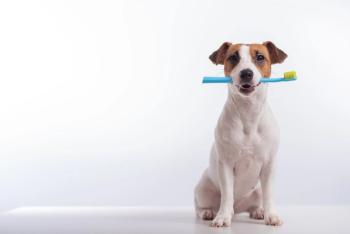
Calcium oxalate disease in cats (Proceedings)
Incidence, diagnosis, treatment, and prevention of calcium oxalate disease.
1) Incidence
a) Significant change over the last 30 years
i) 1981: 78% Struvite; 1% Calcium oxalate (Minnesota Urolith Center)
ii) 1996: 48% Struvite
iii) 1999: 32% Struvite; 55% Calcium oxalate
b) Why the shift?
i) Widespread dietary acidification began in the mid to late 1980s in an attempt to prevent struvite disease
(1) As that happened, calcium oxalate urolithiasis emerged.
(2) Idiopathic hypercalcemia has also emerged.
(3) They may or may not be related.
2) Diagnosis
a) Non-crisis cats
i) Most cats with kidney uroliths have no clinical signs
(1) Possibly persistent or recurrent hematuria, usually without bacteria.
(2) Many cats with bladder uroliths have no or mild clinical signs
(a) Hematuria, dysuria, pollakiuria.
(b) Red Flag: persistent or recurrent hematuria.
b) Crisis cats
i) Ureters
(1) Abdominal pain, lethargy, anorexia, dyspnea
(2) Abdominal palpation may be helpful in establishing pain and localizing it to the abdomen.
ii) Urethra
(1) Abdominal pain, lethargy, anorexia, dysuria
(2) Bladder palpation very helpful in establishing urethral obstruction.
c) Imaging
i) Calcium oxalate uroliths are very dense.
ii) They are usually easily seen on radiographs.
iii) They are usually easily seen on ultrasound.
iv) Size and location are factors with both.
(1) Locations
(a) Kidneys
(b) Ureters *
(c) Urinary bladder
(d) Urethra * If they become lodged in these locations, a crisis exists.
v) Radiology vs. Ultrasound
(1) The difference can be greatly influenced by image quality of both modalities.
(2) Radiographs have the advantage of stopping motion of the abdomen permitting visualization of every structure at one time.
(3) But, hydronephrosis cannot be appreciated on radiographs without an excretory urogram.
(a) Hyapaque replaced by MD-76 R
(b) Give 1-1.5 ml/kg IV
(c) Take a series of radiographs at 3-5 minute intervals until the contrast material is seen in the ureters.
(d) VD and lateral views essential.
(e) Much better visualization if enema is given first.
(f) Very high quality radiographs increase the quality of the study.
(4) Uroliths in the ureters
(a) Radiographs are preferred because the uroliths are often < 2 mm and occur in clusters.
(b) Finding ureteral uroliths with ultrasound requires some (lots of) luck.
(c) An empty bladder makes radiographs less sensitive.
(5) Uroliths in the urethra
(a) Easily seen with radiographs.
(b) Usually missed with ultrasound.
(6) Summary
(a) Radiographs are preferred if ...
(i) You do not have ultrasound.
(ii) High quality radiographs can be made.
(iii) The uroliths are < 2 mm in diameter.
(iv) Multiple uroliths exist.
(v) Uroliths may be in the ureters: all cases with kidney uroliths.
(vi) Uroliths may be in the urethra: when dysuria exists.
d) Stone analysis
i) The gross morphology of calcium oxalate uroliths varies greatly.
ii) Do not try to "analyze" them with your eyes.
iii) Analysis is essential for prognosis and dietary management.
3) Treatment
a) Medical
i) They cannot be dissolved with any known drug or food.
b) Surgical
i) Nephrotomy
(1) Until recently, nephrotomy for urolith removal has been considered an ill-advised procedure because it was thought that 20+% reduction in GFR would follow.
(2) New data: Veterinary Surgery, 2006;35:749-758.
(a) "No significant difference in mean GFR and kidney size of operated versus unoperated kidneys were observed. Individual GFR and renal size of all except 1 cat remained within normal limits."
(b) Technique
(i) IV fluids given pre and post-op.
(ii) was performed with kidney isolation.
(iii) A bulldog clamp was placed over the renal artery (no more than 15 minutes).
(iv) A scalpel incision was made through the capsule and into the parenchyma.
(v) The incision was expended to the pelvis with the scalpel handle for 2/3 the length of the kidney.
(vi) The incision was closed with direct pressure and 5-0 sutures placed in the renal capsule only.
(vii) The bulldog clamp was removed.
(viii) Additional sutures were added on an as-needed basis.
(ix) The surgery was performed on cats with normal renal function.
(x) It needs to be done on many cats with renal disease to see what will happen to the GFR post-operatively.
(3) Take Home: Even if you cannot do the surgery, it can be done
(a) Indications: resistant bacterial infection associated with a urolith, pain, fear of ureteral obstruction.
ii) Ureterotomy
(1) Alternative to surgery: Amitriptyline to induce passage of ureteral stones (VIN 3/14/05): 1 mg/kg q24h PO until urolith passes (usually takes nor more than 3 days)
(a) Only do this if there is good reason to think that there is no obstruction in the ureter. An excretory urogram will verify that.
(2) The internal diameter of the feline ureter is about 1-2 mm.
(3) But, when obstructed, the walls thicken and the lumen proximal to the urolith dilates making surgery feasible.
(4) Recommend: magnification and 5-0 or 6-0 suture material.
(5) Note: Uroliths can move retrograde back into the kidney (JAVMA, Oct. 1, 2006)
(a) Take another radiograph on your way to surgery.
iii) Cystotomy
(1) Indications: Large uroliths in the bladder; small uroliths in the bladder (may move into the urethra and cause an obstruction)
iv) Perineal urethrostomy
(1) Indications: inability to pass urinary catheter; scarring of the urethra; uroliths lodged in the urethra.
(2) Complications: urethral/ostomy stenosis (primarily technique driven); bacterial cystitis.
4) Prevention*
a) To minimize calcium oxalate urolith formation avoid these risk factors.
i) Calcium supplements
ii) Concentrated urine
iii) Drugs (ammonium chloride, methionine) and diets promoting acidosis and acidic urine
iv) Dry diets
v) Foods with high oxalate content
vi) Furosemide
vii) Glucocorticoids
viii) Restricting voluntary urination
ix) Vitamin C supplements
x) Vitamin D supplements
xi) Water restriction
b) My preferred approach
i) Diets that cause diuresis
(1) UR by Purina
(2) S/O by Waltham/Royal Canin
(3) c/d by Hills
*Source: Minnesota Urolith Center, University of Minnesota, College of Veterinary Medicine
Newsletter
From exam room tips to practice management insights, get trusted veterinary news delivered straight to your inbox—subscribe to dvm360.




